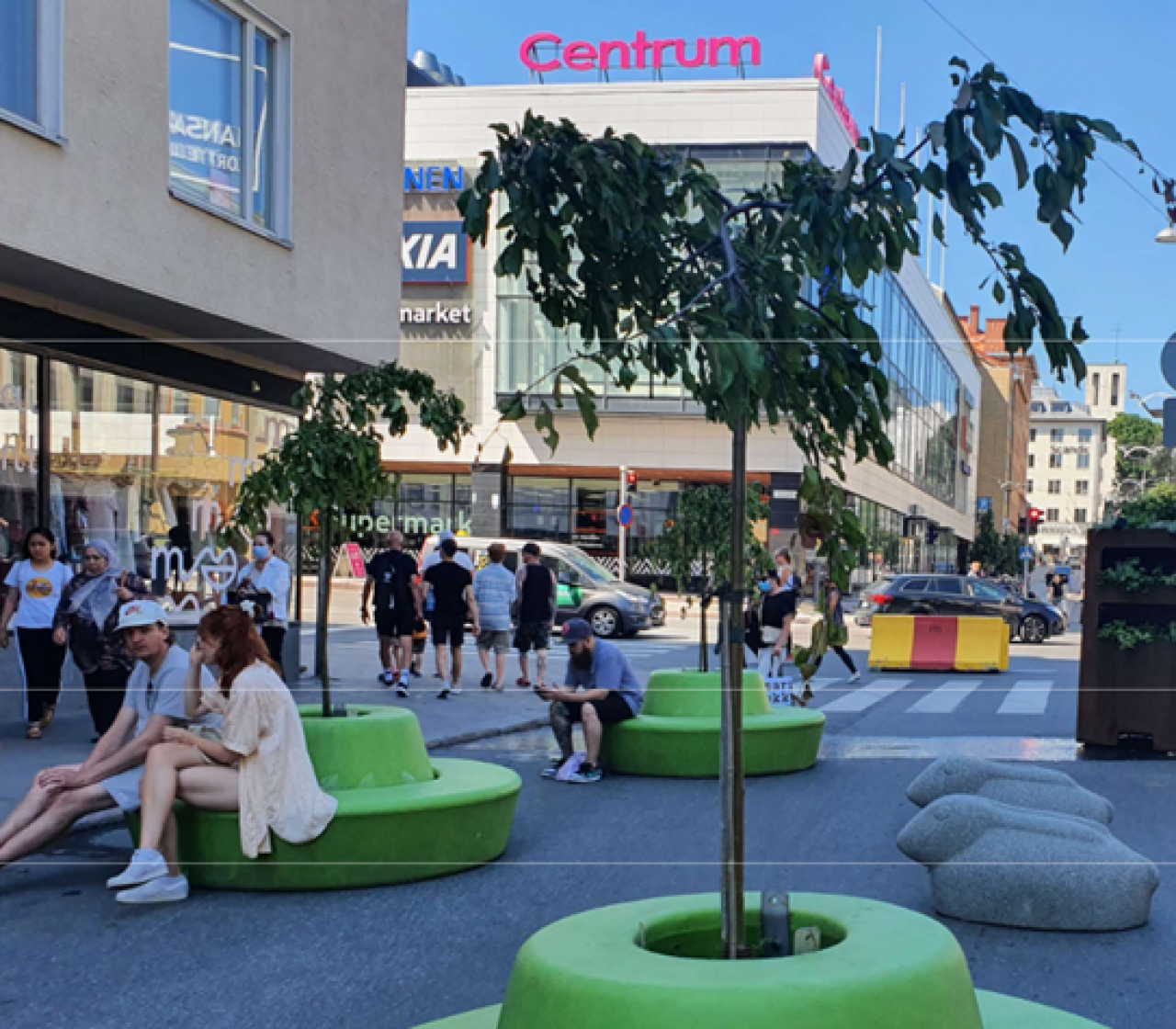
Turku is home to 193,200 inhabitants and is Finland’s third largest city. It is located at the Baltic Sea and is well connected in the Baltic regions to the surrounding countries. Its inner city got rebuilt after the Great Fire of Turku in 1827 and is today structured in rectangular blocks with wide avenues as the central access routes. Central elements of the city centre are the river Aura running at the southern edge and seven hills, both forming the centre’s topography. Historically, green spaces have been concentrated on the hills resulting steep green parks and less green structures in the more level parts of the inner city. Public space alongside the river Aura got revamped to a kilometres long stretch of high quality pubic space including a national park in the last decades.
Turku works on further improving its city centre to an attractive location for living, working, shopping and leisure. One question is how to deal with the streetscape in the centre which it today holding sufficient space for pedestrians, but concentrates providing space for cars and other motorised vehicles. Turku used the opportunity Space4People holds to experiment with a different set of street use showcasing to residents, shopkeepers, gastronomy and visitors how their streets could look like.
The experiment of the Turku Summer Street in the Kristiinankatu
The pilot of the Summer Street took place in a section of the Kristiinankatu, located right in the centre of Turku. The street got closed for traffic from 1st of July 2021 – 31st of August 2021 with the exceptions of residents and delivery access to retailers and gastronomy. Pedestrians and cyclists could cross the area as well. The conditions for the pilot were good: Turku had many inland tourists visiting the city in the summer 2021 and gastronomy could open until midnight or even 2 AM in the morning after previous tougher COVID19 restrictions.
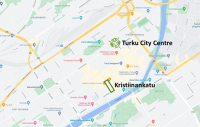
The Summer Street of Kristiinankatu applied a number of elements for experimentation. Taking up the concentration of gastronomy in the southern part of the section, restaurants and cafés placed additional outdoor seating, bars and greeneries on the street. The Northern part was used to place seating, trees, flowerpots and children sitting decorations for the use of everybody. Turku placed “living walls” in the street to explore how vertical greeneries work in streets. Additionally, stalls got placed in this part of the street for distinct events and sales as well as a car-shaped bicycle parking installed to stay permanently.
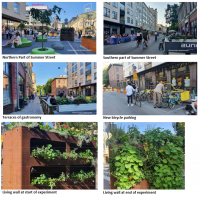
Next to the physical installations, a series of events was used to entertain the street. An event carpet in the form of a 4x6m large painted surface got installed. The event carpet was a winning idea from the Ignite Turku competition and was tested for the first time on the Summer street. The use of the event carpet was free for performances and other non-commercial uses, but for commercial uses a small fee was collected. Times could be booked online. Timeslots were used for about 80% of available time. In addition, the design of the carpet was chosen to serve as an activity spot for children once not booked, which was well taken up by children for jumping and playing. The carpet was booked by the municipality for distinct performances honouring the 10th anniversary of Turku Cultural Capital as well. It was created with asphalt stickers that could get removed after the Summer Street.

Another winning idea from the Ignite Turku competition, tested for the first time on the Summer Street, was the summer market for young entrepreneurs from 12th of July 2021 to 1st of August 2021. The novice entrepreneurs could apply for a stall to present their services and products, and city employees helped them implement their business idea. In August the stalls were used as normal sales stalls, open to be booked for anybody free of charge. A special use case was the collaboration with Turku’s Music Summer Festival: entrance bracelets were sold in the Summer Street combined with discounts in the streets stores and offers in its gastronomy for bracelets’ holders.
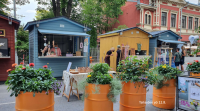
An information board in 3 languages (FI, SE, EN) introduced visitors of the summer street to its features and the experiments’ nature. It introduced as well to the search game for children called “Find Leppis the Ladybug”. Kids were asked to search the summer street for Leppis stickers and to hand in their results by email. The spots where the stickers were to be put were chosen with children in mind regarding the height and different levels of stimulation for the young minds - different materials were chosen to represent a learning experience for them at the same time. During the construction of the Summer Street, altogether 7 stickers were installed into different spots.
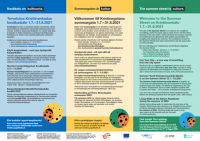
Shopkeepers and gastronomy created an own Instagram account to highlight images, the option to relax and use the area as well as to present themselves and their offers during summer 2021. An exceptional example was the creation of a summer street beer by one of the bars. The summer street was met by particular interest of the local newspapers in Finnish and Swedish, too, who not only reported on the experiment itself, but connected it to discussions on political decision making. Discussions swapped over to Social Media like Facebook as well. The Turku Summer Street got taken up by a national newspaper writing on this and a few further Finnish initiatives of the same kind.
Lessons learnt from the Summer Street
The Summer Street saw most visitors during the afternoon and in the evening, which is attributed to the opening hours of gastronomy in the street respectively. Turku measured the use of the summer street by the Gehl Institutes Stationary People Mapping Tool and traffic counting before and after the experiment. The Stationary People Mapping tool gathers location and activities of people on the street by observations in a 20-minute time slot. The survey was applied 2 times in June before the pilot lifetime and 2 times each in July and August during the Summer Street. Traffic counting for cars, cyclists and pedestrians were done on the same days.
Result in June without any installations were a focus of activities on the southern end of the street where people sat to the largest extend in outdoors gastronomy. In July, daytime observations showed a high use of the benches and of people standing and sitting at the stalls offers, while gastronomy at the southern was not open at this time and therefore less used. In August, concentration was in the Northern part as well with the distinct focus on the stalls connected to the ongoing Turku Arts Night present at the stalls. Most people were strolling in front of the stalls.
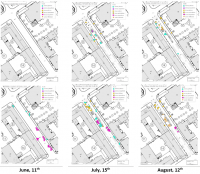
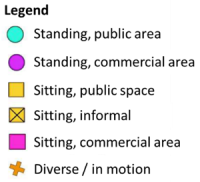
As Turku performed a range of surveys to evaluate the experiment as well. One was directed at the general public and another two were focusing on residents as well as shopkeepers and gastronomy. The survey for the general public worked with inviting people to comment on the summer street. 75% of entries marked the pilot as a good idea but 20% disagreed to this. Negative comments were to a larger extend from residents of the Kristiinankatu, who reported higher noise levels due to more people on the street. In the survey directed to residents, they stated more specifically the loss of on-street parking options and that accessing their flats by car was more difficult during the pilot time. Their feedback on decorative elements were more positive though. Consequently, residents asked for a stronger role in a potential follow-up in the coming years. The shopkeepers and gastronomy survey saw mainly positive responses focusing on the increased sales figures as a result of the summer street. But they asked as well for a stronger role on the installations and designs for a possible iteration in the next year, since some comments claimed that the installations were not to their liking. A clear majority of shopkeepers and retailers would welcome a repetition of the summer street clearly though.
Altogether, the summer street experiment in Turku’s Kristiinankatu was a success as highlighted by the high amount of positive comments. It attracted high interest in local and regional media extending to nation-wide reporting as well as news broadcasting. And for sure it advanced the discussion in Turku on how to best make use of public space in the city centre. Well increasing the awareness on the topic for conservative views to public space use at political and city society’s level, too.

